We are happy to report a new publication from our Viburnum work. Published in the June issue of the American Journal of Botany, our paper - A chloroplast tree for Viburnum (Adoxaceae) and its implications for phylogenetic classification and character evolution - proposes a new classification for major clades of Viburnum. Opposed to using a ranked based classification system, this revision provides phylogenetic definitions for 30 major clades following the guidelines of Phylocode. The results are based on a tree reconstructed from next generation sequence data sampled from whole chloroplasts for 22 species of Viburnum and a 10 gene data set of 113 Viburnum species. The results of these analyses represents the most comprehensive Viburnum phylogeny to date. Additionally, we examine the evolution of eight morphological features including inflorescence architecture, bud morphology, leaf morphology and more.

Spring 2014

Office - 117 Biology Building
Lab - 236 Biology Building
Phone - 609.771.2672
Email - clementw at tcnj.edu
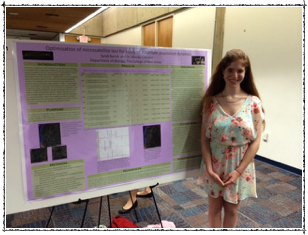
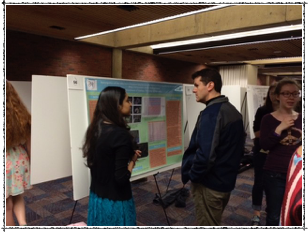
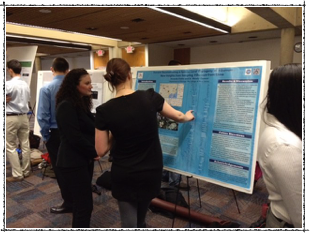
Nitya Chitravanshi explaining her work on unraveling a Viburnum species complex using microsatellite data to Dr. Wund. Nitya’s work, ‘Investigation of the Viburnum dilatatum species complex native to China using microsatellite markers,’ represents her senior thesis.
Alanna Cohen giving her first oral presentation titled, ‘When two are not better than one: how gene duplication affects phylogenetic analysis,’ as part of the faculty-collaborative seminar, Constructing the Past, at the 2014 Celebration of Student Achievement.
Amanda Goble explaining her work on Viburnum phylogeny, ‘Toward reconstructing a species level phylogeny of Viburnum: new insights froms sampling viburnums from China,’ to a fellow student.
Syndi Barish with her poster titled: Optimization of microsatellite loci for study of Viburnum population dynamics. Syndi will apply this work to her project in the fall where she investigates species boundaries of South American viburnums.
From left to right: Nitya Chitravanshi (’14), Alanna Cohen (’15), Syndi Barish (’16), Patrick Gallagher (’16), TJ Stammer (’17), Amanda Goble (’16), and Wendy Clement.
Kudos!
Congratulations to Syndi Barish who is a 2014 recipient of the prestigious Goldwater scholarship! Read about it here.
Congratulations to Nitya! Our first Clem Lab graduate!
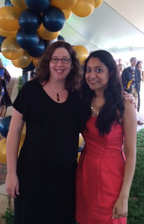
Highlights from: Celebration of Student Achievement 2014

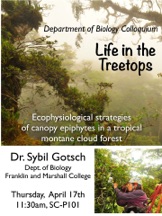
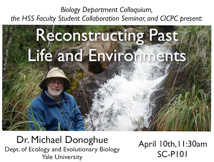
After a fantastic year, we at the Clem Lab have much to celebrate as many of our members head off to incredible summer experiences. Before leaving, Alanna, Amanda, Nitya and Syndi all presented their work at the 2014 TCNJ Celebration of Student Achievement - see below for a few highlights of the events.
As the summer begins we wish the best to all of our members and their summer endeavors. Congratulations to Alanna who was accepted to an REU program at Cornell, Amanda who is working as a Museum Technician at the Peabody Museum of Natural History at Yale University, Patrick who was accepted to an REU program at UC Riverside, and Syndi who was accepted to an REU program at Cold Spring Harbor. Also, congratulations to Syndi who was named a 2014 Goldwater Scholar! Lastly, congratulations and our best wishes to Nitya, our first Clem Lab graduate - she will be pursuing a Masters of Science at Rutgers University this fall.
New publication!
Spring visitors
This spring we were fortunate to have to incredible visitors to the Clem Lab who also gave departmental seminars. First, Dr. Sybil Gotsch of the Biology Department at Franklin and Marshall College, gave an excellent seminar on her plant ecophysiology work in Central America. Titled ‘Life in the treetops,’ Dr. Gotsch took us on an incredible journey through her research that occurs in the canopy and explained how she and her students climb trees to be able to study epiphytes and their physiology while perched in trees far from the ground.
We were incredibly excited to welcome and host our collaborator, Dr. Michael Donoghue, for his first visit to TCNJ. While here, Michael spoke at our ‘Constructing the Past’ faculty-collaborative research seminar, and he gave a departmental seminar titled ‘Reconstructing Past Life and Environments.’ Everyone was able to discuss their current work and progress on various Viburnum projects with Michael, as well as learn more about the findings of recent Viburnum fieldwork in the Philippines.
On to the summer!
